 |
Главная |
COMPUTATIONAL FLUID DYNAMICS
|
из
5.00
|
Computational fluid dynamics (CFD) provides insight into transient and turbulent flow. The mechanical principles governing fluids and solids are the same. CFD uses numerical methods such as the finite element method, the finite difference method, the boundary element method, and the finite volume method. It allows analysis and optimization of structural component geometry for efficient fluid flow. It also allows one to view pressure, velocity, and temperature in the flow.
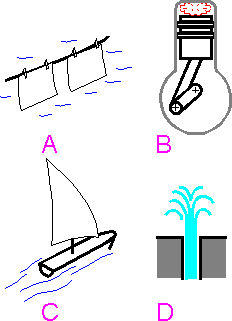 Dynamics is the study of motion of objects.
Dynamics is the study of motion of objects.
A fluid actually means anything that isn't a solid. Both air and water are fluids from this point of view. Fluids are considered as any "shapeless" substance which cannot remain at rest under a sliding stress.
The following are examples of the problem that can be solved by CFD:
A. Hanging wet clothes out to dry.
B. Burning gasoline in an automobile engine.
C. Sailing.
D. A jet of water issuing from a slit.
E. Dissolution.
F. Melting, boiling .
G. Mechanical movement of a fan.
H. Gas flow in jet engine.
 n the CFD-based analysis the Navier-Stokes equations take the form of a large system of nonlinear equations. There are three fundamental principles of computational fluid dynamics:
n the CFD-based analysis the Navier-Stokes equations take the form of a large system of nonlinear equations. There are three fundamental principles of computational fluid dynamics:
Energy is conserved.
Mass is conserved.
Momentum is conserved.
 Temperature, the pressure, the three velocity components, and density are typical variables for fluid flow. The flow variables can be stored at the center of the computational cell (Cell Centered methods) or at the vertices of the cell (Cell Vertex or Vertex Centered methods). The acoustic-fluid model is the simplest: the fluid only transmits pressure waves, fluid-particle motions are small. Only one degree of freedom (the potential) needs to be calculated at each finite-element node in potential-based analysis.
Temperature, the pressure, the three velocity components, and density are typical variables for fluid flow. The flow variables can be stored at the center of the computational cell (Cell Centered methods) or at the vertices of the cell (Cell Vertex or Vertex Centered methods). The acoustic-fluid model is the simplest: the fluid only transmits pressure waves, fluid-particle motions are small. Only one degree of freedom (the potential) needs to be calculated at each finite-element node in potential-based analysis.
 CFD simulates steady and unsteady flow in air and in boundary layers. The mesh is created to represent the air configuration surrounding a solid. The mesh is more dense for the boundary layers.
CFD simulates steady and unsteady flow in air and in boundary layers. The mesh is created to represent the air configuration surrounding a solid. The mesh is more dense for the boundary layers.
Zones with turbulence flow demand a fine local grid resolution. Zone A for water falling from a step is an example of such a region
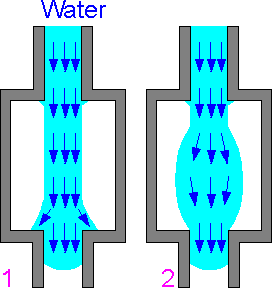 There are two different quantitive results for a jet of water issued at a constant low velocity (<5 cm/s) from a long slit into air chamber:
There are two different quantitive results for a jet of water issued at a constant low velocity (<5 cm/s) from a long slit into air chamber:
1. The distortion in the inlet hole can be observed in the exact model and the experiment.
2. The enlargement of the flow in the center may be caused by numerical errors in the boundary layer between water and air.
 This is a rough estimation of the turbulence depending on Reynolds Number Re. Re is meant to measure the relative importance of fluid inertia to viscous forces. Outside the boundary layer, the flow is independent of the Reynolds Number. Viscous forces are negligible if the Reynolds number is large.
This is a rough estimation of the turbulence depending on Reynolds Number Re. Re is meant to measure the relative importance of fluid inertia to viscous forces. Outside the boundary layer, the flow is independent of the Reynolds Number. Viscous forces are negligible if the Reynolds number is large.
n is the kinematic viscosity of the fluid;
L and U are characteristic length and velocity scales for a flow.
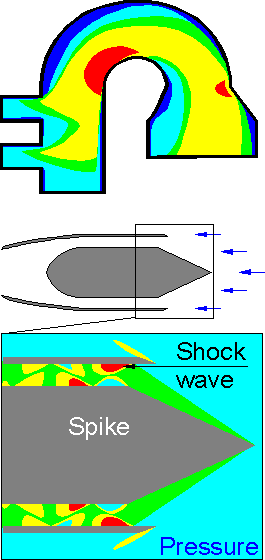 The result of CFD modeling is color contours of pressure, velocity, and temperature. Contrary to solid bodies where stress concentration usually takes place at notches or holes, the concentration of CFD parameters can be observed on a smooth surface.
The result of CFD modeling is color contours of pressure, velocity, and temperature. Contrary to solid bodies where stress concentration usually takes place at notches or holes, the concentration of CFD parameters can be observed on a smooth surface.
Supersonic flow in a jet engine with a spike: the primary shock wave originates at nose of the spike and impinges on the inner surface of the intake nozzle. This is a the region of pressure concentration.
The relative difficulty or ease of the CFD-based analysis depend on dimensionality in time (varying or not varying with time), dimensionality in space (one- , two-, or three-dimensional space), complexity of the geometry of the solids, and complexity of the flow-influencing boundary conditions. If available computer resources are not sufficient for the necessary numerical accuracy, and assumptions were made for the input data the result of CFD-based modeling may not be reliable . The reliability is greater for laminar rather than turbulent flows, and for chemically-inert rather than chemically-reactive gases.
DESIGN ANALYSIS
FEA is used to optimize design, guarantee safety, reduce design-cycle time, weight, costs, and the need for testing.
Practitioners can use FEA
- to prove design safety;
- to meet code requirements;
- to modify an existing design;
- to test new and competing designs;
- to peer inside design and see phenomenon that cannot be measured with experimental methods.
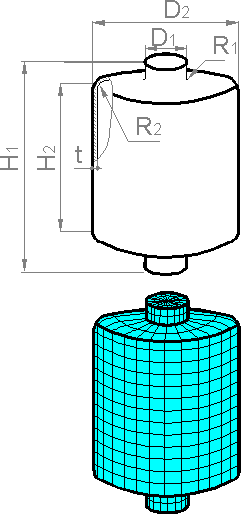 Now FEA packages are integrated with solid modeling and computer aided design (CAD) systems. CAD is the use of geometric or solid modeling programs to aid in the creation or modification of a design. A structure may be drawn in solid model form by one of the many CAD packages available. Wireframe is a geometric representation of 3D model as outlined by its outer edges. The model is transferred to a FE software, where it is meshed and boundary conditions are specified. The stresses, displacements, temperatures and other parameters are results of the FE solution. The results help to make decisions on changes in structure design, loads or service regimes. CAD and FEA are becoming integrated.
Now FEA packages are integrated with solid modeling and computer aided design (CAD) systems. CAD is the use of geometric or solid modeling programs to aid in the creation or modification of a design. A structure may be drawn in solid model form by one of the many CAD packages available. Wireframe is a geometric representation of 3D model as outlined by its outer edges. The model is transferred to a FE software, where it is meshed and boundary conditions are specified. The stresses, displacements, temperatures and other parameters are results of the FE solution. The results help to make decisions on changes in structure design, loads or service regimes. CAD and FEA are becoming integrated.
A FEA analysis is not simply translating a CAD file and watching the results. Considerable care and skill has to be employed to be sure that the results correspond to the reality and all scenarios are taken into account.
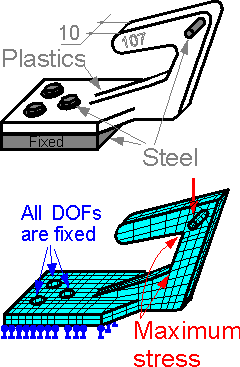 Transferring a model from a CAD system assumes some simplification of the model. The fillets in the area of maximum stress concentration are the subject of detailed analysis.
Transferring a model from a CAD system assumes some simplification of the model. The fillets in the area of maximum stress concentration are the subject of detailed analysis.
 Fillets are not always modeled in detail. If the calculated maximum stress is large then one of the possible ways to guarantee the safety of the new structure is in correct design of fillets which can decrease stress concentrations.
Fillets are not always modeled in detail. If the calculated maximum stress is large then one of the possible ways to guarantee the safety of the new structure is in correct design of fillets which can decrease stress concentrations.
 FEA is also used to calculate nominal stresses in different regions of the structure. The FEA can be useful in comparing of old and new designs with similar manufacturing technologies. If nominal stresses in the model of a new design are smaller than for the old the conclusion of the analysis is the new design is at least as safe as the old one.
FEA is also used to calculate nominal stresses in different regions of the structure. The FEA can be useful in comparing of old and new designs with similar manufacturing technologies. If nominal stresses in the model of a new design are smaller than for the old the conclusion of the analysis is the new design is at least as safe as the old one.
 There are about 100 types of standard finite elements in commercial FE packages. Automatic meshing procedures can divide the sub-areas on standard elements. There are no plane elements with 5 or 11 nodes. The number of nodes in a finite element cannot be chosen arbitrary.
There are about 100 types of standard finite elements in commercial FE packages. Automatic meshing procedures can divide the sub-areas on standard elements. There are no plane elements with 5 or 11 nodes. The number of nodes in a finite element cannot be chosen arbitrary.
FEA solves problems using
 Stress Analysis Stresses, displacements, deflections are calculated for static loading.
Stress Analysis Stresses, displacements, deflections are calculated for static loading.
Steady-state or Transient Heat Transfer Predicting temperature distribution for an object exposed to heating, radiation, convection and conduction.
Thermal Stress Analysis Stresses and displacement due to thermal expansion are a subject of the analysis.
Transient Dynamic Objects in rapid motion or under impact are studied to obtain maximum stresses, deflection. Dynamic incremental nonlinear analysis assumes not one, but many solution steps for nonlinear system. Time for solution of the problem is significantly higher than for static analysis problem.
Modal Analysis Vibration characteristics such as natural frequencies and mode shapes are calculated.
Fluid Flow Fluid flow in gases, air, and water is modeled to find temperatures, pressures, velocities, etc.
Linear Buckling Calculates the load at which a structure is likely to fail due to elastic instability.
Non Linear Analysis Analysis for large deflections and nonlinear material behavior such as plastic.
 Nonlinear problems are solved by with step-by-step increments of applied loads F. At each step the material constant (effective modulus of elasticity) changes depending on the level of stress intensity in the FE for a previous step and material behavior ('stress-strain' diagram). At each loading step the components of the stiffness matrix change according to the new level of stress. It is better to avoid infinitely large or negative diagonal components of the stiffness matrix. This can lead to numerical "oscillation" and errors in the analysis.
Nonlinear problems are solved by with step-by-step increments of applied loads F. At each step the material constant (effective modulus of elasticity) changes depending on the level of stress intensity in the FE for a previous step and material behavior ('stress-strain' diagram). At each loading step the components of the stiffness matrix change according to the new level of stress. It is better to avoid infinitely large or negative diagonal components of the stiffness matrix. This can lead to numerical "oscillation" and errors in the analysis.
REFERENCES
Bathe K.J. Finite Element Procedures, Prentice Hall, 1996.
Knight C.E. The Finite Element Method in Mechanical Design, PWS-KENT Publishing Company, 1993.
What Every Engineer Should Know About Finite Element Analysis edited by J.R. Brauer, Marcel Dekker Inc., 1988.
Zienkiewicz O.C.The Finite Element Method, 4th Edition, McGraw Hill Book Company, New York, 1989.
THEMES
Theme 1. Stress Concentration
Theme 2. Fracure Mechanics
Theme 3. Mechanical Properties
Theme 4. Strength of Materials
Theme 5. Theory of Elasticity
Theme 6. Structural Safety
Theme 7. Material Science
Theme 8. Welds
Theme 9.Composite Materials
Theme 10. Finite Element Analysis
_____________________ 2011______________________
_____________________ 2011______________________ter>
_____________________ 2011______________________/html>
_____________________ 2011______________________/html>
|
из
5.00
|
Обсуждение в статье: COMPUTATIONAL FLUID DYNAMICS |
|
Обсуждений еще не было, будьте первым... ↓↓↓ |

Почему 1285321 студент выбрали МегаОбучалку...
Система поиска информации
Мобильная версия сайта
Удобная навигация
Нет шокирующей рекламы

